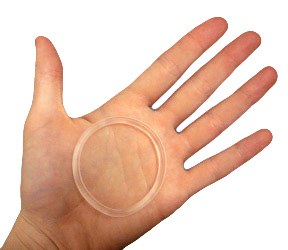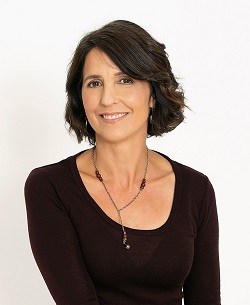Related Research Articles

Estrogen or oestrogen is a category of sex hormone responsible for the development and regulation of the female reproductive system and secondary sex characteristics. There are three major endogenous estrogens that have estrogenic hormonal activity: estrone (E1), estradiol (E2), and estriol (E3). Estradiol, an estrane, is the most potent and prevalent. Another estrogen called estetrol (E4) is produced only during pregnancy.

Menstruation is the regular discharge of blood and mucosal tissue from the inner lining of the uterus through the vagina. The menstrual cycle is characterized by the rise and fall of hormones. Menstruation is triggered by falling progesterone levels and is a sign that pregnancy has not occurred.
Menopause, also known as the climacteric, is the time in women's lives when menstrual periods stop permanently, and they are no longer able to bear children. Menopause usually occurs between the age of 48 and 52. Medical professionals often define menopause as having occurred when a woman has not had any menstrual bleeding for a year. It may also be defined by a decrease in hormone production by the ovaries. In those who have had surgery to remove their uterus but still have ovaries, menopause may be considered to have occurred at the time of the surgery or when their hormone levels fell. Following the removal of the uterus, symptoms typically occur earlier, at an average of 45 years of age.

Progesterone (P4) is an endogenous steroid and progestogen sex hormone involved in the menstrual cycle, pregnancy, and embryogenesis of humans and other species. It belongs to a group of steroid hormones called the progestogens and is the major progestogen in the body. Progesterone has a variety of important functions in the body. It is also a crucial metabolic intermediate in the production of other endogenous steroids, including the sex hormones and the corticosteroids, and plays an important role in brain function as a neurosteroid.

The menstrual cycle is a series of natural changes in hormone production and the structures of the uterus and ovaries of the female reproductive system that make pregnancy possible. The ovarian cycle controls the production and release of eggs and the cyclic release of estrogen and progesterone. The uterine cycle governs the preparation and maintenance of the lining of the uterus (womb) to receive a fertilized egg. These cycles are concurrent and coordinated, normally last between 21 and 35 days in adult women, with a median length of 28 days, and continue for about 30–45 years.
Premenstrual syndrome (PMS) refers to emotional and physical symptoms that regularly occur in the one to two weeks before the start of each menstrual period. Symptoms resolve before the start of bleeding. Different women experience different symptoms. The common emotional symptoms include irritability and mood changes while the common physical symptoms include acne, tender breasts, bloating, and feeling tired Often symptoms are present for around six days. An individual's pattern of symptoms may change over time. Symptoms do not occur during pregnancy or following menopause.

Estradiol (E2), also spelled oestradiol, is an estrogen steroid hormone and the major female sex hormone. It is involved in the regulation of the estrous and menstrual female reproductive cycles. Estradiol is responsible for the development of female secondary sexual characteristics such as the breasts, widening of the hips and a female-associated pattern of fat distribution. It is also important in the development and maintenance of female reproductive tissues such as the mammary glands, uterus and vagina during puberty, adulthood and pregnancy. It also has important effects in many other tissues including bone, fat, skin, liver, and the brain.

A progestogen, also referred to as a progestagen, gestagen, or gestogen, is a type of medication which produces effects similar to those of the natural female sex hormone progesterone in the body. A progestin is a synthetic progestogen. Progestogens are used most commonly in hormonal birth control and menopausal hormone therapy. They can also be used in the treatment of gynecological conditions, to support fertility and pregnancy, to lower sex hormone levels for various purposes, and for other indications. Progestogens are used alone or in combination with estrogens. They are available in a wide variety of formulations and for use by many different routes of administration. Examples of progestogens include natural or bioidentical progesterone as well as progestins such as medroxyprogesterone acetate and norethisterone.
Hot flashes are a form of flushing, often caused by the changing hormone levels that are characteristic of menopause. They are typically experienced as a feeling of intense heat with sweating and rapid heartbeat, and may typically last from two to 30 minutes for each occurrence.
Abnormal uterine bleeding (AUB), also known as atypical vaginal bleeding, is vaginal bleeding from the uterus that is abnormally frequent, lasts excessively long, is heavier than normal, or is irregular. The term dysfunctional uterine bleeding was used when no underlying cause was present. Vaginal bleeding during pregnancy is excluded. Iron deficiency anemia may occur and quality of life may be negatively affected.
The anovulatory cycle is a menstrual cycle by varying degrees of menstrual intervals and the absence of ovulation and a luteal phase. In the absence of ovulation, there will be infertility.

Vaginal rings are polymeric drug delivery devices designed to provide controlled release of drugs for intravaginal administration over extended periods of time. The ring is inserted into the vagina and provides contraception protection. Vaginal rings come in one size that fits most women.

Dydrogesterone, sold under the brand name Duphaston among others, is a progestin medication which is used for a variety of indications, including threatened or recurrent miscarriage during pregnancy, dysfunctional bleeding, infertility due to luteal insufficiency, dysmenorrhea, endometriosis, secondary amenorrhea, irregular cycles, premenstrual syndrome, and as a component of menopausal hormone therapy. It is taken by mouth.
Jerilynn C. Prior is a Canadian endocrinologist and medical doctor specializing in menstrual cycles and the effects of hormones on women's health. She has been called a leader in understanding and treating perimenopause and menopause. She was born in the USA and moved to Canada in 1976, and has taken citizenship there.
Hormone replacement therapy (HRT), also known as menopausal hormone therapy or postmenopausal hormone therapy, is a form of hormone therapy used to treat symptoms associated with female menopause. These symptoms can include hot flashes, vaginal atrophy, accelerated skin aging, vaginal dryness, decreased muscle mass, sexual dysfunction, and bone loss. They are in large part related to the diminished levels of sex hormones that occur during menopause.

Catamenial epilepsy is a form of epilepsy in women where seizures are exacerbated during certain phases of the menstrual cycle. Seizures may rarely occur only during certain parts of the cycle, but are more commonly only more frequent. Catamenial epilepsy is underlain by hormonal fluctuations of the menstrual cycle where estrogens promote seizures and progesterone counteracts seizure activity.

Progesterone (P4) is a medication and naturally occurring steroid hormone. It is a progestogen and is used in combination with estrogens mainly in hormone therapy for menopausal symptoms and low sex hormone levels in women. It is also used in women to support pregnancy and fertility and to treat gynecological disorders. Progesterone can be taken by mouth, in through the vagina, and by injection into muscle or fat, among other routes. A progesterone vaginal ring and progesterone intrauterine device used for birth control also exist in some areas of the world.
The pharmacology of progesterone, a progestogen medication and naturally occurring steroid hormone, concerns its pharmacodynamics, pharmacokinetics, and various routes of administration.

Seed cycling is the rotation of different edible seeds into the diet at different times in the menstrual cycle. Practitioners believe that since some seeds promote estrogen production, and others promote progesterone production, that eating these seeds in the correct parts of the menstrual cycle will balance the hormonal rhythm.

Lara Briden is a naturopathic doctor, women’s health speaker, and author of the books Period Repair Manual and Hormone Repair Manual, published by Pan Macmillan. She has consulting rooms in Christchurch, New Zealand, and travels widely to speak on women’s health.
References
- ↑ "UBC endocrinologist receives SMCR Ann Voda Lifetime Achievement Award". UBC People. University of British Columbia. 30 June 2011. Retrieved 10 May 2013.
- 1 2 3 "Older hormone therapy as good as estrogen for hot flashes, trial suggests". CBC News. 26 Jan 2007. Retrieved 10 May 2013.
- ↑ Barton, Adriana (18 Jun 2012). "Progesterone may ease hot flushes, study finds". Globe and Mail. Retrieved 10 May 2013.
- ↑ "Celebrating 10 years! Centre for Menstrual Cycle and Ovulation Research (CeMCOR)". Vancouver Coastal Health Research Institute. Retrieved 10 May 2013.
- 1 2 Buck, Pauline (2002). "The New Centre for Menstrual Cycle and Ovulation Research". BC Endocrine Research Foundation. 4 (1). Archived from the original on 3 March 2016. Retrieved 10 May 2013.
- 1 2 3 Werschler, Laura (22 Jan 2013). "The value of ovulation to women's health". Troy Media. Archived from the original on 26 June 2018. Retrieved 10 May 2013.
- 1 2 3 "Menstrual Cycle and Ovulation (CeMCOR)". Research Centres. Vancouver Coastal Health Research Institute. Archived from the original on 23 May 2013. Retrieved 10 May 2013.
- ↑ Woolley, Pieta (9 Jan 2008). "Doc offers new view of menopause pills". Georgia Straight. Archived from the original on 30 April 2013. Retrieved 10 May 2013.
- ↑ George, Lianne (12 Dec 2005). "The end of the period". Maclean's. Archived from the original on 28 June 2013. Retrieved 10 May 2013.